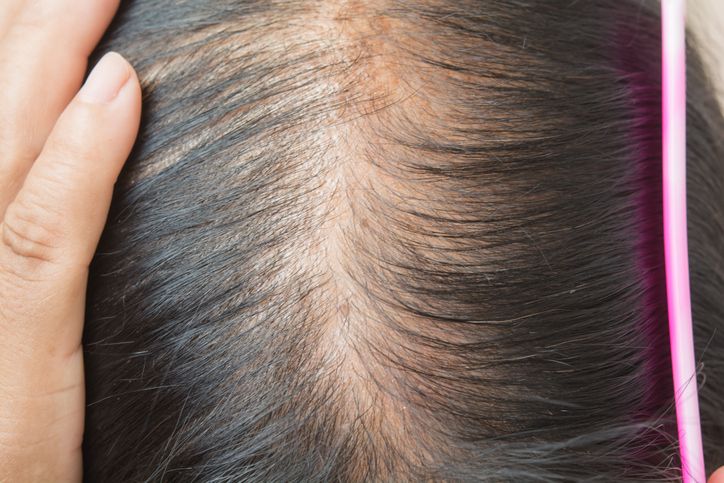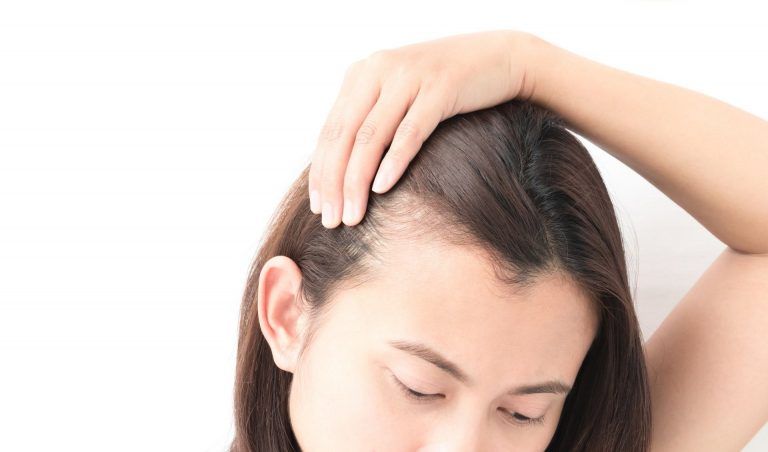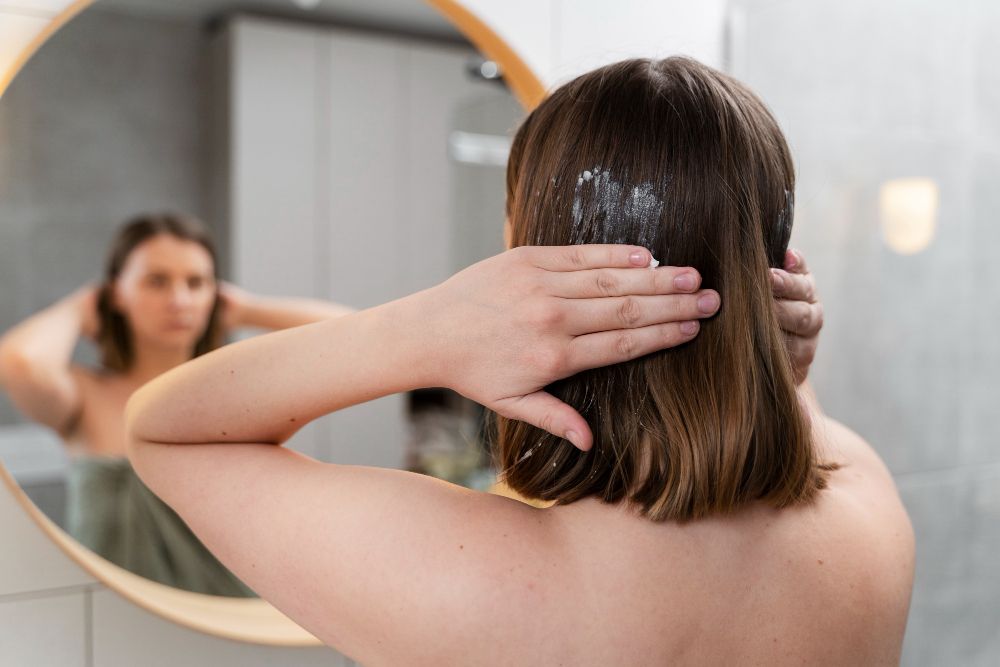- Home
- Trend
- Weight Loss Strategies
- Acne Tips
- Hair Health Information
- Blemish Removal Tips
- Acne Scar Removal Tips
- Muscle Building Techniques
- Intimate Care Tips
- Postpartum Intimate Care
- Eye Bags Wiki
- Tips for Face Slimming
- Secret of Permanent Hair Removal
- Breast Enlargement Tips
- Cure to Snoring
- Marionette Lines
- Skin-Tightening Secrets
Seborrheic alopecia is not just a condition that affects men. In recent years, an increasing number of women are also experiencing seborrheic hair loss. Symptoms include increased dandruff, excessive oil secretion on the scalp, and a greasy scent in the hair. This can even lead to common hair loss issues such as receding hairlines, bald spots, and M-shaped hairlines. Seborrheic alopecia, also known as "seborrheic hair loss" or "oil-related hair loss," is closely related to excess scalp oil. In Traditional Chinese Medicine (TCM), it is referred to as "hair decay fungus." If women experience excessive oil on their scalp and increased dandruff, this is a warning sign of hair loss. To prevent seborrheic alopecia and other types of hair loss in women, lifestyle, diet, and personal habits should be adjusted. Below is a quick guide on seborrheic hair loss. Don't miss out on more details!
What is Seborrheic Alopecia?

Seborrheic alopecia is a common type of hair loss, accounting for about 40% of all hair loss cases. While it is more common in men, women can also experience it. In individuals with seborrheic alopecia, the scalp produces an excessive amount of oil, which coats the hair roots and follicles, preventing the hair from receiving the necessary nutrients to grow. As a result, the hair becomes thinner starting from the root and eventually falls out, leading to hair loss.
There are two types of seborrheic alopecia:
Acute Seborrheic Alopecia:
Patients with acute seborrheic alopecia experience excessive scalp oil, itching, and increased dandruff in a short period. They may even develop scalp sores, and hair will fall out in clumps. Although treatable, it may recur after recovery.
Chronic Seborrheic Alopecia:
Chronic seborrheic alopecia patients will have excessive oil production, causing the hair to become greasy and sticky. Dandruff appears in patches or chunks, and hair loss typically starts at the crown, leading to receding hairlines, M-shaped hairlines, and baldness. Female patients may also experience dry hair, thinning at the crown, and exposed scalp. Chronic seborrheic alopecia can last from several years to over a decade, affecting the patient’s appearance long-term.
Causes of Seborrheic Alopecia

Like other forms of hair loss, seborrheic alopecia is influenced by both genetic factors and personal lifestyle choices. If you're worried about developing seborrheic alopecia, check out the following points to see if you're at high risk:
Cause 1: Genetics
Genetics is one of the most common causes of hair loss, and seborrheic alopecia is no exception. Hair loss genes can be inherited, so if your parents have hair loss problems, you may also be at risk. The most common inherited hair loss is male pattern baldness, where hair follicles shrink rapidly, leading to receding hairlines, bald spots, and M-shaped hairlines.
Additionally, seborrheic alopecia is related to the sebaceous glands. Some individuals naturally produce more sebum, causing the scalp to become oily, leading to greasy hair. This is known as oily scalp. If an oily scalp is not managed properly, the oil can cover the entire scalp, making it difficult for hair follicles to absorb nutrients, thus leading to seborrheic alopecia.
Cause 2: Lifestyle Habits
Personal dietary habits can influence the likelihood of developing seborrheic alopecia. For example, individuals who frequently consume high-fat, greasy, or stimulating foods may notice increased oil production on their scalp as the body expels excess oils through the skin. Over time, this can clog the hair follicles, making it hard for the roots to absorb nutrients, leading to hair loss. Irregular sleep patterns, staying up late, and stress can also disrupt hormonal balance, increasing oil secretion and exacerbating hair loss.
Cause 3: Personal Constitution
From a Traditional Chinese Medicine perspective, individuals with excessive liver heat or imbalanced qi and blood circulation are more likely to develop seborrheic alopecia. Lifestyle habits can also affect the body’s internal balance. Poor habits can disrupt hormone regulation and impede nutrient delivery to the hair follicles, making the hair more fragile. Additionally, hormonal imbalances may increase male hormones in women, activating dihydrotestosterone (DHT), which attacks hair follicles and leads to hair loss.
Cause 4: Emotional Stress
Emotional stress can also increase the risk of seborrheic alopecia. Long-term mental strain, excessive worry, and constant tension can add pressure to the scalp, disrupting blood circulation and affecting nutrient supply to the hair follicles. Given the high stress levels in urban life, this can lead to a deficiency in the liver and kidneys, which further exacerbates sebum production and causes seborrheic alopecia.
Cause 5: Excessive Cleaning
Many people with seborrheic alopecia wash their hair more frequently due to excess oil, believing that frequent washing can solve the problem. In reality, the scalp secretes oil to protect the hair. Those with oily scalps already produce more oil than usual, and excessive washing can strip away this essential oil. As a result, the scalp produces even more oil to compensate, leading to a vicious cycle where the hair becomes oilier with each wash.
免費體驗
F8 Hair Regrowth Treatment
1 Minute Self-Registration
Date should not be before minimal date
Symptoms of Seborrheic Alopecia
It’s not just slightly oily hair that indicates seborrheic alopecia, but excessive oil production combined with other symptoms. If you notice any of the following signs, it's advisable to consult a specialist for a scalp check.
Symptom 1: Excessive Oil Production
Excessive oil is a common symptom of seborrheic alopecia. The scalp becomes coated with a layer of oil, making hair appear greasy. Even in cases of receding hairlines or bald spots, the scalp will appear shiny due to excess oil production.
Symptom 2: Odor and Itching
The buildup of oil on the scalp can make it harder for dirt to be removed, which can lead to bacterial growth and unpleasant odors. This issue worsens during hot weather. Moreover, the presence of bacteria can cause itching, and severe itching may affect one's appearance, as people may scratch their scalp frequently.
Symptom 3: Increased Dandruff
Dandruff increases as oil production rises, forming flakes or clumps that may adhere to hair roots. If you suddenly notice a lot of flakes when you previously had no dandruff problems, this could indicate seborrheic alopecia.
Symptom 4: Hair Loss
While increased oil may seem unrelated to hair loss, it is often a precursor. Excess oil can clog hair follicles, preventing them from absorbing nutrients, leading to thinning hair that eventually falls out. In severe cases, large amounts of hair may fall out when combing or washing, starting from the crown and spreading outward.
How to Improve Seborrheic Alopecia?
Since seborrheic alopecia is related to lifestyle habits, making adjustments to diet, rest, and daily routine can help alleviate symptoms like excess oil, dandruff, and odor. Here are several targeted ways to address seborrheic alopecia. These tips are helpful even for those who don’t yet suffer from this condition and are looking to prevent it.
Method 1: Increase Protein and Vitamin Intake
Protein is a key nutrient for hair growth. Those with seborrheic alopecia should consume protein-rich foods like milk, eggs, fish, seafood, and soy to provide essential nutrients for healthy hair growth. Vitamins A and B6 can also help regulate oil production on the scalp. Foods like spinach, chives, almonds, carrots, potatoes, sesame, and oranges are rich in these vitamins.
Method 2: Proper Stress Relief
Excessive emotional stress can tighten scalp muscles, affecting blood circulation and leading to more oil production. To combat this, practice stress-relieving activities like exercise, music, or relaxation techniques to improve overall well-being and support healthier hair growth.
Method 3: Adequate Rest
Traditional Chinese Medicine believes that insufficient rest can deplete the liver and kidneys, leading to poor nutrient supply to the hair. Maintaining a good sleep schedule, such as going to bed early, is essential for rejuvenating the body and improving hair health.
Method 4: Maintain Scalp Health
Patients with seborrheic alopecia should pay extra attention to scalp health. Regularly clean the scalp to reduce oil and dandruff buildup. It may also be beneficial to use medicated shampoos, but avoid over-washing, which could worsen the oil problem.
Treatments for Seborrheic Hair Loss
Fortunately, seborrheic hair loss is not an incurable condition. If hair loss issues are detected early and professional consultation with a hair loss specialist is sought, appropriate treatments can reverse seborrheic hair loss. The treatment methods for seborrheic hair loss can generally be divided into traditional Chinese medicine (TCM) and Western medicine approaches. Both use different methods to address the issue and target seborrheic hair loss effectively.
1. Traditional Chinese Medicine (TCM) Treatment
As is well known, TCM tends to be gentler in nature, focusing on adjusting the overall body constitution and addressing health issues at their root. The TCM approach to treating seborrheic hair loss involves understanding the patient's constitution and identifying the causes of excessive scalp oil and dandruff, as well as evaluating the health of the hair and hair follicles.
Additionally, TCM aims to strengthen the spleen and eliminate dampness, as well as to soothe the liver and supplement the kidneys. This is to address the deficiencies in liver and kidney energy that lead to a lack of essence and blood, which may contribute to hair loss. Depending on the situation, suitable herbal remedies may be prescribed either for topical application or oral use. These remedies help to regulate the body constitution, fortify health, and target issues like scalp oil and dandruff, while also addressing the areas affected by hair loss.
Advantages: Gentle in nature, tailored to individual constitution, and aims to treat the root cause of seborrheic hair loss.
Disadvantages: Results take time and adjustments may be required depending on the individual’s response to treatment.
2. Western Medicine Treatment
Western treatments for seborrheic hair loss are known for their fast-acting results in promoting hair growth. These treatments mainly include medications, hair growth solutions, and topical products. In cases of severe hair loss, a hair transplant may be required to regenerate hair follicles.
3. Hair Growth Medications and Medicinal Hair Growth Solutions
Currently, two common medications used to treat seborrheic hair loss are finasteride (oral medication) and minoxidil (topical solution). Finasteride, taken orally, prevents the conversion of testosterone into dihydrotestosterone (DHT), a hormone that contributes to hair loss. However, this medication is currently only recommended for men, and hair loss may return if the medication is stopped.
Minoxidil, a common ingredient in topical hair growth solutions, is available in various forms, including foam, lotions, and solutions. Minoxidil is suitable for both male and female patients with seborrheic hair loss, though women should only use products with no more than 2% minoxidil content and must do so under a doctor’s prescription. Visible improvements are usually observed after 3 to 6 months of consistent use, but hair loss will likely return once the medication is discontinued. Therefore, minoxidil is not considered a long-term solution for seborrheic hair loss.
Advantages: Results can be seen in as little as 3 months, and the medications and solutions are easy to use.
Disadvantages: Hair loss will recur once treatment is stopped; oral medications are not suitable for women; and using hair growth solutions may cause scalp sensitivity or itching.
4. Hair Transplant Surgery
Many patients suffering from seborrheic hair loss choose hair transplant surgery as a treatment. Hair transplant surgery involves transferring healthy hair follicles from one part of the scalp to the bald or thinning areas to restore hair growth. There are two main types of hair transplant surgeries: FUT (Follicular Unit Transplantation) and FUE (Follicular Unit Extraction). In both procedures, healthy hair follicles are extracted either by scalp incision (FUT) or follicular drilling (FUE), then transplanted into the affected areas in a process resembling "planting seeds," resulting in the growth of thick and natural-looking hair.
However, hair transplant surgery is costly and typically recommended for individuals with severe hair loss. Even after a transplant, if the scalp’s oil production problem is not addressed, hair follicles may become blocked, leading to the recurrence of seborrheic hair loss.
Advantages: The hair growth results are visible and natural, and can last for years or more.
Disadvantages: It is an invasive procedure with a high cost and a risk of failure, including potential bacterial infections in hair follicles.
免費體驗
F8 Hair Regrowth Treatment
1 Minute Self-Registration
Date should not be before minimal date
Effective Solution for Seborrheic Hair Loss: Perfect Medical F8 Hair Regrowth Treatment
Many individuals with seborrheic hair loss face issues with excessive scalp oil production. To address seborrheic hair loss effectively, the root cause—excess oil secretion—must be tackled by unclogging blocked hair follicles, nourishing the scalp, and helping the hair grow back strong and healthy.
For those who prefer not to take Western medication or are concerned about the slower results of TCM, the Perfect Medical F8 Hair Regrowth Treatment is a great alternative. This treatment is specifically designed to address various scalp and hair problems, bringing back healthy, shiny, voluminous, and elastic hair for women.
The Perfect Medical F8 Hair Regrowth Treatment uses 650nm LLLT low-energy laser technology to introduce powerful hair-nourishing factors into the scalp, promoting scalp renewal and overall health. It also encourages the generation of capillaries, strengthening hair follicles and improving hair color. Additionally, the treatment deeply cleanses the scalp pores, removing dead skin cells and chemical residues, reducing oil secretion, and enhancing blood circulation to nourish the hair, restoring healthy hair quality and stronger hair growth.
The Perfect Medical F8 Hair Regrowth Treatment not only helps improve seborrheic hair loss but also prevents common hair loss problems. For those who wish to prevent hair loss, the non-invasive and painless F8 treatment is an excellent choice for maintaining scalp and hair health.
Book Today: Perfect Medical F8 Hair Regrowth Treatment免費體驗
F8 Hair Regrowth Treatment
1 Minute Self-Registration
Date should not be before minimal date
FAQ

What symptoms are associated with seborrheic hair loss?
Excessive oil production, scalp odor, increased dandruff, and hair loss are common symptoms of seborrheic hair loss. This happens because excess oil coats the scalp, making the hair greasy and attracting bacteria that cause odor. Seborrheic dandruff appears in flakes or chunks, sticking to the hair roots. Over time, hair thins from the roots and falls out, leading to conditions like male-pattern baldness, bald spots, or receding hairlines.
Can almond oil or honey massaging the scalp improve seborrheic hair loss?
Many people claim that home remedies like massaging the scalp with almond oil or honey, or applying ginger and brandy to the hair loss areas, can improve hair loss and promote hair growth. While some individuals may experience success with these methods, they are not universally effective. As of now, there is no solid scientific evidence supporting these remedies as solutions for hair loss. Improper use of these methods may cause scalp irritation or worsen the hair loss issue. If you’re experiencing hair loss, it’s best to seek professional medical advice rather than relying on unverified home remedies.
Are men more likely to experience seborrheic hair loss than women?
Yes. Men are more likely to be affected by seborrheic hair loss due to genetic factors that influence hair loss. Male hormones, such as testosterone, convert into dihydrotestosterone (DHT), which attacks and weakens hair follicles. Additionally, men typically have more oil production than women, which can lead to follicle blockage. However, women can also experience seborrheic hair loss, especially if they consume a lot of oily or spicy foods or neglect scalp health, which can increase oil production and dandruff, affecting hair health.
Does diet affect seborrheic hair loss?
A person’s diet can influence the likelihood of developing seborrheic hair loss. Consuming high-fat, high-oil, and highly stimulating foods increases the chances of seborrheic hair loss. These foods release excess oil through the skin and scalp pores, leading to increased scalp oil production. Over time, the excess oil blocks hair follicles, preventing the hair roots from receiving proper nutrients and causing hair loss.
Can hair growth solutions improve seborrheic hair loss?
Hair growth solutions containing minoxidil can help treat seborrheic hair loss. These products are available in foam, lotion, and solution forms. However, female patients with seborrheic hair loss should only use minoxidil products containing no more than 2% minoxidil and must use them under a doctor’s prescription. After 3 to 6 months of use, improvements in hair loss may be seen. However, if discontinued, the hair loss is likely to return, so hair growth solutions are not considered a long-term solution for seborrheic hair loss.









